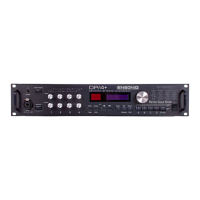Section 1 - Tutorial
Simple Editing
Once
you
have
selected a preset, you can edit it. Algorithms, parameters, routings,
and
configurations can all
be
edited
and
are covered
in
more
detail
in
later sections
of
the
manual.
Here
are a few simple editing steps to begin
understanding
the
DP
/ 4's full potential.
Choosing Units to Edit
Before
you
can
edit
the algorithms, you need to select each
unit
individually:
1.
Press Edit.
2
Press Unit
A,
B,
C,
or D to select that unit's algorithm (effect) for
editing
. The active
unit's
LED should be lit. The LED display should say "00,"
if
not,
3.
Press the Left Arrow button until the display looks similar to this:
~:~lgorithM
NaMe
Mix=50 UoluMe=99
Choosing Different Algorithms
After
you
've chosen a unit, the LCD display will
show
several things. First, the letter
in
the
upper
left
hand
comer
shows which unit
is
active.
In
this
case, it's
Unit
A. This is followed
by
the
algorithm
name
that is located
in
Unit A (name flashing). The second line
shows
the
mix
of
the effect to the
dry
signal,
and
the volume of the algorithm.
•
Tum
the Data Entry
Knob
to select any of the available effect algorithms. The LED display
will
show
the single effect algorithm preset location,
and
after one
second
it
will "zero
out"
to
the first parameter of the algorithm. This zeroing
out
loads
that
algorithm
into the selected
unit,
replacing the algorithm that was there previously. Try selecting several
new
algorithms
in
this manner.
Editing the Mix
• Press the
Right
Arrow
button
once to select the Mix
parameter
(01
in
the
LED
Numeric
display). The mix amount will be flashing. Move the
Data
Entry
Knob
clockwise or counter
clockwise to change the mix ratio of the effect to the
dry
signal. As
soon
as
you
change
the
mix
value (with the
Data
Entry Knob), the Edit LED flashes. This indicates
that
you
have
now
changed
a parameter from its default value,
and
the
newly
edited
version is
in
the
EDIT
BUFFER.
By
pressing the Edit button you can toggle
between
the
original setting (LED
solidly lit)
and
the newly edited version (LED flashing) of
that
parameter.
The
parameter
values
shown
in
the display always reflect
what
is currently
being
done
to process the signal.
In
other
words,
what
you see is
what
you
hear.
Changing the Parameters
All of
the
other parameters within the selected
unit
can be
edited
in
the
same
fashion:
• Use the Left
and
Right Arrow buttons to select the parameters,
and
the
Data
Entry
Knob
to
change the values of the active parameter.
ENSONIQ DP/4 Musician's Manual
11

